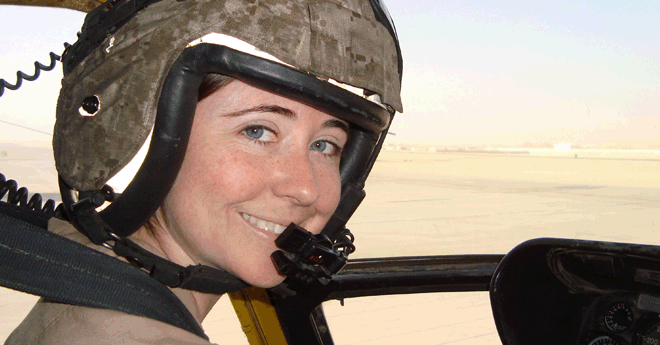TILLMAN TUESDAY: Sarah-Blythe Ballard Is Pushing the Boundaries of Aviation Medicine
Pat Tillman Foundation can’t fulfill its mission to empower military veterans and their spouses without the generosity of our supporters across the country. Nationwide, over 400 Tillman Scholars are striving to impact our country and communities through their studies in medicine, law, business, policy, science, education and the arts. Every “Tillman Tuesday,” we are committed to highlighting the individual impact of a Tillman Scholar, focusing on their success in school, career and community—all thanks to your support. This week we learn more about 2015 Tillman Scholar Sarah-Blythe Ballard who joined the U.S. Navy in 2002 at the same time she began medical school. Since 2012, Lieutenant Commander Ballard has been stationed in Peru, where she is working towards a vaccine for Malaria while completing her dissertation for her Ph.D. in International Health from Johns Hopkins University.
NEAR THE END OF COLLEGE, YOU DECIDED TO JOIN THE MILITARY. WHAT INSPIRED YOU TO MAKE THAT DECISION?
“I’ll preface this by saying that, growing up as an Air Force brat, I never imagined myself joining the military. However, I’d say my career developed by “saying yes” to a series of opportunities. In undergrad, I landed an HIV vaccine development internship at the CDC, and started becoming really interested in global health. I was applying for medical school when 9/11 happened, and I felt compelled to serve my country by joining the military to practice medicine in the international arena. After completing medical school and internship, I had the opportunity to go to flight school, and I said yes to that. During my flight surgery deployments in Iraq and Afghanistan, I got a feel for what our troops needed on the ground, so now I feel more equipped to respond to those needs. My experience is that, throughout the career development process, you get placed in certain situations that allow you to grow as a person and a professional. The career opportunities build off of that. It’s hard to say that I started out with a vision of myself being here at this point in time because it was more of a natural, organic evolution.”
HOW DID YOU END UP BECOMING A NAVY FLIGHT SURGEON?
“After internship, Navy physicians have the opportunity to serve as General Medical Officers (GMOs). When I found out the Navy sends its flight surgery GMOs through the actual flight training syllabus at the Naval Aerospace Medicine Institute, I was absolutely sold on the idea. During our operational tours following training, flight surgeons act as primary care physicians for their squadrons and also serve an administrative function, which includes human factors analyses and mishap investigation. Any time a plane crashes or someone gets hurt on the flight line, it’s the flight surgeon’s responsibility to be a part of the team that responds and investigates. For me, that was a really touching process because these are your people and you’re responding to accidents in which they’ve been involved. It’s pretty horrific, but by figuring out the root cause of the crash at hand, you have the opportunity to help others avoid that same situation. They say our operational manual for flight is written in blood because, while you are responding to these often-terrible situations, you are contributing to a body of knowledge that will hopefully help others in the future. Because of this experience as a flight surgeon, I became more interested as a physician in public health practice and injury prevention. When I returned stateside to do Preventive Medicine residency and a PhD in global disease epidemiology, a part of me really missed doing aviation medicine, so I started doing civil aviation crash analysis as a hobby with the Hopkins Center Injury Prevention and Control and have tried to maintain my involvement with that community.”
YOU ARE STILL SERVING ACTIVE DUTY AND ARE CURRENTLY STATIONED IN PERU. HOW MANY TIMES DID YOU DEPLOY PREVIOUSLY AND WHAT WAS YOUR ROLE DURING THOSE DEPLOYMENTS?
“It’s hard to count up all the deployments and detachments. My first flight surgery assignment was with the “Skinny Dragons,” a Navy P-3C Orion squadron that deployed to Iraq in 2008-09 and detached to El Salvador, Qatar, Bahrain, and Italy. In 2008, we hosted the Rim of the Pacific Exercise (RIMPAC) in Hawaii, and I also did a short humanitarian civic assistance stint in Djibouti, Africa, during those years. My next squadron, the Marine Corps CH-53D squadron “Ugly Angels,” deployed to Helmand province in Afghanistan from 2010-11. Leading up to that deployment, our squadron got to support a lot of cool training events, like Weapons and Tactics Instructor training (Marine Corps “Top Gun”) in Arizona and Lava Viper on the Big Island of Hawaii. After residency, I took an NIH Fogarty fellowship to research child mortality in Peru, and was then offered a Fulbright scholarship to stay longer to complete that research. Soon after, the Ebola epidemic broke out in West Africa and I was recruited by International Medical Corps to serve as an Emergency Doctor at one of their Ebola Treatment Units in Liberia, where I had the good fortune of collaborating with Navy and Public Health Service physicians, albeit from the civilian side, which provided a lot of perspective. Since then, I’ve returned to Peru as the Parasitology Department Head at Naval Medical Research Unit No. 6. Truth be told, apart from training periods, I’ve been functioning almost entirely outside the continental U.S. since joining the Navy.”
WAS AEROSPACE AND PREVENTIVE MEDICINE WHAT LED YOU TOWARDS INVESTIGATING MISHAPS?
“Mishap investigation was a huge part of my job as a flight surgeon. In that role, I responded to and investigated aviation crashes all over the world. Throughout that time, though, I remained heavily involved in global health/tropical medicine and emergency response, my other big interests. When I started a global disease epidemiology-focused preventive medicine residency at Hopkins after my operational tours, I had to start doing the aviation aerospace safety medicine on this side because it didn’t fit into my clinical epidemiology practice. Even now, at my billet at the Navy overseas research lab in Peru, I do tropical disease research focused on malaria in the Amazon jungle, but it doesn’t apply directly to flight medicine. So, after completing the Preventive Medicine board certification, I pursued board certification in Aerospace Medicine on my own time. However, it’s always been a struggle because the fields are so incredibly different that I feel like I always have to choose between them – on the global health side, you have very limited resources that you’re using to make vaccines accessible to children, improve pregnant mothers’ access to obstetric care, or promote some other aspect of public health in low-resource settings. On the aerospace medicine side, you are working with complex aviation programs that cost a ton of money. I have an interest in both for different reasons, and it wasn’t actually until the Ebola response that I was finally able to put the two of them together. At the time, I was a Fulbright doing research in South America, and I received a notice from the U.S. State Department, encouraging doctors to submit their CVs to the State-sponsored Non-government Organizations that were in desperate need of physicians to provide direct patient care to Ebola patients in West Africa. After my initial stint with International Medical Corps as an Emergency Doctor, State decided to fund the organization to develop a domestic air evacuation system for Ebola suspect cases in Liberia. It was kind of uncanny because they needed a board certified physician with aerospace expertise and, not only international leadership and disaster management expertise, but hands-on experience providing direct patient care to Ebola patients in remote tropical settings. I mean, seriously, how many people fit that description?”
WHERE DOES YOUR INTEREST FROM AVIATION COME FROM?
“I’ve always been completely enamored with pushing the limits of human performance and what we can do as individuals and a society in order to make things better for the human race. It’s fascinating to see what is possible – I’ve always been fascinated with aviation as it relates to that. I was never eligible to be a pilot because of my poor eyesight, so when I joined the Navy and learned there was an opportunity for me to go to flight school, learn how to fly at the controls as a co-pilot, AND be a physician making a difference downrange, there was no question as to whether or not I would apply.”
WHAT IS A TYPICAL DAY OR WEEK LIKE FOR YOU IN PERU?
“Every day in Peru is new and different, and I wouldn’t have it any other way. I’m currently the Parasitology Department Head at Naval Medical Research Unit No. 6 in Lima, Peru. We have project sites throughout Peru, with our main site in the Amazon jungle city of Iquitos, Peru, which is the largest city in the world not accessible by road. Our main focus is Malaria, and my team has created a process where we have patients infected with Malaria and we have a special kind of free-breeding mosquito colony that we feed malaria-infected blood and wait for the Malaria to develop to the appropriate infectious stage. From that point we can dissect the parasite from the mosquito and look at the infectious particles in order to evaluate potential immunity-inducing antibodies and what they look like so we can do vaccine development. You can actually use those infectious particles to challenge vaccines in order to see how effective they are in preventing malaria infection. We’re making a lot of progress – which is great. There has never been a vaccine for a parasite before so the Malaria vaccine development process is challenging. The other project that we just started is led by a collaborator at Princeton University and involves mice. The vivax malaria we have in the Amazon has a liver stage, and our collaborators have developed a chimeric mice model with humanized livers that can be infected with the infectious stage of the malaria that we dissect from the mosquitos, so we can study human liver-stage infection without having to infect a human.”
AS A WHOLE WITH THE TIME YOU’VE BEEN IN THE SERVICE AND EVEN THE TIME YOU’VE SPENT IN PERU, WHAT HAVE YOU LEARNED ABOUT YOURSELF AND WHAT HAVE YOU LEARNED ABOUT THE WORLD THAT YOU DIDN’T KNOW BEFORE?
“It’s incredibly humbling to see what a tiny piece we are as human beings in the world, and what an impact we can make if we’re passionate about something. For me personally, there are a lot of challenges living abroad and working in new and different environments. When you show up in a place like Peru, or anywhere, you’re like a baby – you can’t talk, you can’t move around, you don’t know the culture, and you are forced to rely on other people. That is a very humbling experience. I’ve been really lucky to be able to be integrate into many scientific and community networks abroad, meet people that have similar goals, and be push innovations and scientific/disaster relief efforts forward. I’ve learned there are always going to be challenges but you just have to focus on the positive things and move toward what you want your legacy to be.”
ASIDE FROM THE FINANCIAL COMPONENT, WHAT HAS THE TILLMAN SCHOLARSHIP PROVIDED YOU THE OPPORTUNITY TO DO THAT YOU MAY NOT HAVE OTHERWISE HAD?
“The Tillman Scholar community is really a source of inspiration. The networks we have the opportunity to be plugged into are filled with amazing people and make the really hard days tolerable. The community of scholars is inspiring and that’s really where I derive my strength from – the good in other people. It’s an honor and a blessing to be part of it.”
WHEN YOU FINISH YOUR DISSERTATION AND RETURN FROM PERU, WHAT DOES YOUR IDEAL DREAM JOB LOOK LIKE?
“If I could find some way to keep merging global health and aviation medicine with disaster response it would be amazing. I’m not sure how that could happen, and maybe something else will come up that steers my course in a different direction, but right now my heart is steering me toward aviation medicine and injury prevention in the occupational and disaster settings.”
LAST QUESTION! WHERE DOES YOUR NAME “SARAH-BLYTHE” COME FROM?
“Hyphenated first names are so pretentious, aren’t they?! The short story is that I’m a fifth generation “Sarah,” so my mother gave me a double name to keep the confusion to a minimum! Blythe is a family name from an ancestor who served in the U.S. Navy during the Revolutionary War. My mother hyphenated it so people wouldn’t mistake it for a last name.”




